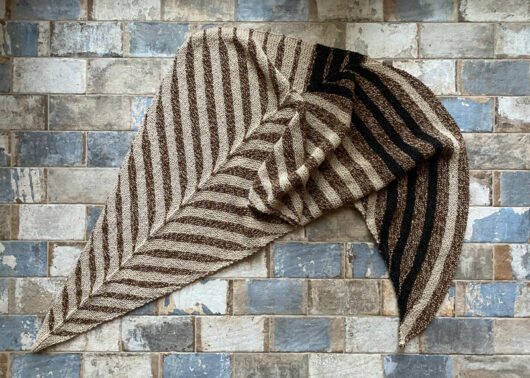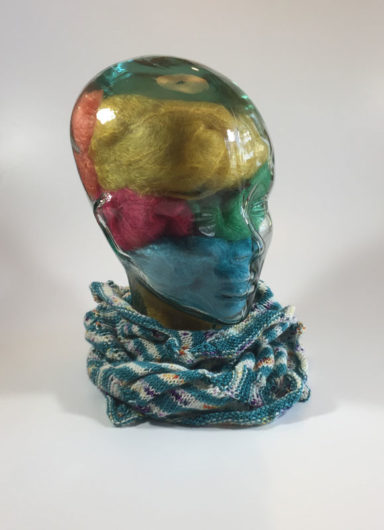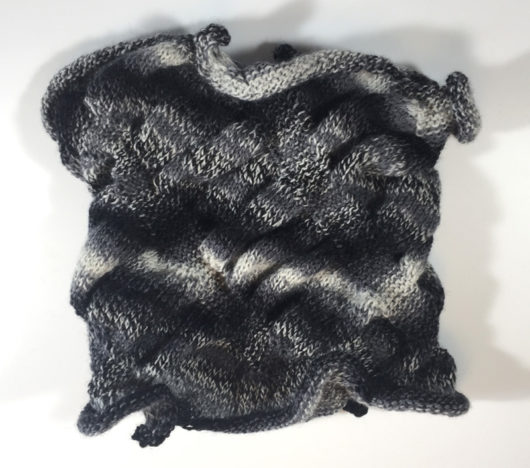I am beyond pleased with how my new shawl worked out. It’s Mrs. Watson, by Martina Behm. Actually, it’s Mrs. Watson on steroids. More on that in a bit.
My shawl is 100% sportweight alpaca. It was handspun from an alpaca herd owned by Christa Newhouse. She, along with her husband Shelby, owned Insel Haus on Bois Blanc Island for many years. (It’s “The Hideaway at Bois Blanc” now.) Anyway, my Yarn Dreamer alpaca was spun from two alpacas whose names I know: Leisl and Cressida. I needed a special pattern for this special yarn. It’s been in my stash for about 10 years, waiting for that special pattern. Mrs. Watson was it for sure.
My Mrs. Watson is huge. At its widest it’s 27 inches. That central double decrease spine is 56 inches long. From tip to tip it’s 75 inches, not following the curve. That compares to 20 by 66 inch dimensions as originally designed.
It was difficult for me to figure out how to keep the beautiful short row design features while still widening and lengthening the shawl.
Until I purchased the pattern I couldn’t figure out how this shape is achieved. Ok. I figured short rows. But that swoosh? And that graceful shape?
The knitting begins at the lower left and the work increases at both edges for…awhile. Then the stitch count stays the same for the rest of the shawl. I knew that to widen the shawl I’d have to continue the increases. So that’s what I did. I added three of the marled brown leaves and then started in just blindly following the pattern. Blindly is the key word, unfortunately.
I had GOBS more yarn than I needed. Gobs. That’s a knitting term of art, right? No worries that I’ll run out of yarn, right? Eventually I understood the pattern and worried I’d run out of the lighter shade of yarn.
What I failed to appreciate may already be obvious to you. The shape of the shawl will be all wonky if that central double decrease doesn’t end with (basically) no stitches on one side of the decrease. But I had bunches more of stitches since I’d widened the shawl by adding 3 full pattern repeats (“body” and “leaf” in the pattern’s lingo). And it’s a subtle but beautiful design feature that those short row leaves change shape as the knitting progresses.
Bottom line, if you work extra leaves before “body” pattern 2, you need to work that same number of extra leaves in the later leaf patterns to get the shape (and spine) to work out correctly. And all the added leaves need to include an accompanying extra body section. I think I know that’s super hard to understand unless you’re actually knitting the pattern. But hopefully it will be of help to someone working the shawl who, like me, decided to widen it. Going into leaf pattern 8, you should end up with 7 stitches beyond the CDD “spine,” which is exactly what’s needed. I worked 3 extra sets of leaf (and body) pattern 7. It worked.
Here’s another look at this beauty before I go on with the rest of my tale about how this knitting yarn got to a happy ending.
I eventually understood that I would run out of the lighter color alpaca. Since each lighter section takes exactly the same amount of yarn, I weighed my remaining ball of that color before and after a section to figure out how much yarn one section needed. I figured it might look like I’d planned the added color if I completed the shawl with one strip of the lighter shade. So I saved enough yarn for that.
My supply of alpaca was lower than low. But I had an almost-600 yarn skein of Heritage Prime Alpaca in a marled black/gray labeled sportweight. Unfortunately it was a very lightweight sportweight. And the rest of my shawl is a very beefy sportweight. Having a limp section at one end of the shawl wouldn’t do. I started hunting around in my stash for a laceweight or fingering weight yarn I could add to the black/gray alpaca to get to the correct weight. I was so sad that my 100% alpaca shawl was going to have to diversify and include some merino. Maybe you heard my groans and sobs?
I was about to add in some black fingering weight merino. Then I remembered a farm stall a zillion years ago selling laceweight alpaca. Had I…? Yes! I keep a little stash of black yarn set aside to sew critter eyeballs and noses. I had a ball of very fine black alpaca in my critter faces stash. Held together with my Heritage Prime that yarn gave me essentially the same weight as the beefy Yarn Dreamer. Maybe you heard my joyful hoots and hollers?
I’ve been wearing this shawl almost non-stop lately, especially through recent frigid mornings when it’s been as cold as 15 degrees below zero (Farenheit). In my world, there’s nothing like alpaca for warm.
This alpaca was part of Christa’s flock. Maybe it’s even Leisl.












































